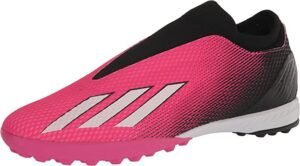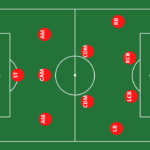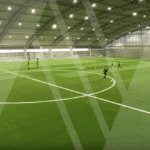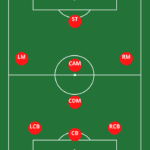- Last Updated -
The answer to the question:
can indoor soccer shoes be used on turf?…… IS YES!
The type of shoe you wear can impact your performance, safety, and comfort when playing soccer. Two common playing surfaces for soccer are indoor courts and turf fields.
Both indoor soccer shoes and turf soccer shoes are specialized for each surface, but what happens when a player decides to use their indoor soccer shoes on turf? This question has been debated by players, coaches, and experts alike in the world of soccer.
Affiliate Disclosure: Some of the links in this article may be affiliate links, which can provide compensation to me at no cost to you if you decide to purchase.

Click Links See Blow – BEST Soccer Cleats For Indoor And Turf

Indoor Soccer Shoes
Indoor soccer shoes are designed specifically for playing on hard court surfaces. They usually have flat soles with minimal traction patterns that reduce the chances of slipping while providing good ball control. They are also lightweight to allow for quick movements and easy maneuvering in small spaces.
In addition to their design features, indoor soccer shoes also come in different materials such as leather or synthetic fabrics like mesh or nylon. The type of material affects the shoe’s durability and breathability.
Turf Surfaces
Turf surfaces are artificial grass fields made up of synthetic fibers woven into a backing material called infill. Infill holds the fibers upright while also providing cushioning similar to natural grass fields. Turf surfaces offer consistent playability regardless of weather conditions making them ideal for year-round play.
Compared to natural grass fields, turf surfaces have less traction because they don’t provide much grip underfoot. This means that players need cleats with longer studs or cleats specifically designed for use on turf to prevent slipping.
Overview: Indoor Soccer Shoes vs Turf?
One question players often ask is whether they can use their indoor soccer shoes on turf. Some players like the flat, lightweight design of indoor soccer shoes for the flexibility they provide when playing on turf. Others argue that they are not suitable for turf surfaces due to their lack of traction and support.
In this article, we will explore the advantages and disadvantages of wearing indoor soccer shoes on turf. We will compare indoor soccer shoes with other types of soccer shoes and analyze whether using them on turf is safe and effective.
Ultimately, we will aim to provide players with advice on what type of shoe to wear depending on their playing surface. So let’s dive into it!
Indoor Soccer Shoes
Description of Indoor Soccer Shoes’ Design and Features
Indoor soccer shoes are designed to provide players with optimal performance on indoor surfaces, which are typically made of smooth hardwood or concrete. The shoes have a low profile, lightweight design that allows for quick movements and precision control.
They often have a flat sole with small nubs or patterns that help provide grip on the indoor surface. One of the most important features of indoor soccer shoes is their upper construction.
Typically made from synthetic materials such as leather or mesh, these shoes have a snug fit that molds to the player’s foot. This provides maximum control and feel for the ball while dribbling, passing, and shooting.
Advantages and Disadvantages of Using Indoor Soccer Shoes on an Indoor Surface
Using indoor soccer shoes on an indoor surface has several advantages. First, since they are specifically designed for these types of surfaces, they offer excellent traction and grip compared to other types of soccer shoes. This helps players maintain their balance while executing quick movements.
Another advantage is that indoor soccer shoes are generally more lightweight than other types of soccer shoes, which can reduce fatigue during extended play sessions. Additionally, the low profile design ensures that players stay close to the ground, providing greater stability during lateral movements.
However, using indoor soccer shoes on an outdoor surface can also pose some disadvantages. Since they lack studs or cleats like traditional outdoor soccer cleats do, they may not provide enough traction when playing on wet grass or muddy conditions.
Comparison with Other Types of Soccer Shoes
In comparison with other types of soccer shoes such as outdoor cleats or turf trainers, indoor soccer shoes offer unique advantages specific to playing on smooth indoor surfaces. Compared to outdoor cleats which have larger studs or blades for better traction in grassy fields; indoor soccer footwear provides players with the ability to make quick turns, cuts, and pivots without worrying about their studs getting caught in the turf.
Turf shoes, on the other hand, are designed for artificial turf surfaces, which have a different texture and require specific types of traction. While indoor soccer shoes may provide some grip on a turf surface, they may not offer enough stability or support to prevent injuries on this type of playing surface.
Indoor soccer shoes are an excellent option for players looking to maximize performance on smooth indoor surfaces. While they may not be suitable for outdoor play or certain types of artificial turf surfaces, they provide unparalleled control and feel that can help take your game to the next level.
Turf Surfaces
Description of turf surfaces’ characteristics
Turf surfaces are a type of playing surface that is commonly used for soccer and other sports. Turf surfaces are made up of synthetic grass fibers that are held in place by a layer of rubber pellets or sand.
The grass fibers are typically shorter than natural grass, ranging from 0.5 to 1 inch in length, and the surface is usually harder than natural grass. One advantage of turf surfaces is that they can be used year-round, regardless of weather conditions.
They also require less maintenance than natural grass, which needs to be mowed, watered, and fertilized regularly. However, one disadvantage of turf surfaces is that they can get very hot during the summer months, which can be uncomfortable for players.
Advantages and disadvantages of using different types of soccer shoes on turf
There are several types of soccer shoes available on the market today, each with its advantages and disadvantages when it comes to playing on a turf surface. For example, traditional cleats have long studs or spikes that can dig into the surface and provide better traction; however, this type of shoe may not be as comfortable on hard turf as it would be on softer ground.
Indoor soccer shoes have flat soles with small tread patterns designed for use on indoor courts; however, these shoes may not provide enough traction on a turf surface due to their lack of cleats or spikes. Turf shoes are specifically designed for use on artificial surfaces like turf; they have shorter studs or nubs that provide better traction without damaging the surface as longer cleats might.
The main advantage of using turf shoes over other types is their ability to grip synthetic grass fibers without creating too much wear and tear. However, one disadvantage is that these shoes may not work as well on wet or slippery surfaces.
Comparison with other types of playing surfaces
Compared to natural grass, turf surfaces provide a more consistent playing surface that is less affected by weather conditions. They also require less maintenance, which can save time and money for sports facilities.
However, they can be harder on players’ bodies due to the increased impact on joints and bones. Compared to indoor courts, turf surfaces provide more space for players to move around in and can offer a more realistic soccer experience.
However, they may not be as comfortable or safe as indoor courts due to the harder surface and potential for injury. Overall, when it comes to playing soccer on a turf surface, players need to choose the right type of shoe based on their individual needs and preferences.
Turf shoes are designed specifically for this type of surface and can provide better traction without damaging the field. However, traditional cleats or indoor soccer shoes may still be viable options depending on the player’s style of play and comfort level.
Can Indoor Soccer Shoes Be Used on Turf?
Why Some Players Choose to Wear Indoor Soccer Shoes on Turf
There are several reasons why some players choose to wear indoor soccer shoes on a turf surface. One reason is that indoor soccer shoes typically have a flat, non-cleated sole that provides good traction on hard surfaces.
This can also make them suitable for use on turf surfaces, which are typically more forgiving than hard indoor surfaces. Another reason some players prefer to wear indoor soccer shoes on turf is that they are generally lighter and more flexible than traditional cleats.
This can be an advantage for players who rely on speed and agility, as it allows them to move quickly and change direction with ease. Some players may also find that indoor soccer shoes provide better ball control and touch than other types of cleats, which can be an advantage when playing on a surface that requires precision and finesse.
Analysis if Wearing Indoor Soccer Shoes is Safe and Effective on a Turf Surface
While it is possible to wear indoor soccer shoes on a turf surface, there are some potential risks to consider. One concern is that the flat sole of the shoe may not provide enough traction or support when running or cutting on the uneven surface of the turf.
Additionally, since turf surfaces tend to be harder than grass or dirt fields, there is a greater risk of injury if players are not wearing appropriate footwear with adequate padding and support. Without proper cushioning underfoot, players may be at greater risk for foot and ankle injuries such as sprains or fractures.
Despite these potential risks, many players find that wearing indoor soccer shoes on turf can be effective if done safely. To minimize the risk of injury, players need to choose shoes with adequate cushioning and support, as well as maintain proper form while running and cutting.
Discussion About the Potential Risks and Benefits
When considering whether to wear indoor soccer shoes on a turf surface, players should carefully weigh the potential risks and benefits. On the one hand, wearing indoor soccer shoes can provide good traction, flexibility, and ball control on a turf surface.
However, players must also consider factors such as safety and comfort. Without proper cushioning or support, wearing indoor soccer shoes on turf could increase the risk of injury or discomfort.
Ultimately, the decision whether to wear indoor soccer shoes on a turf surface will depend on each player’s individual preferences and needs. Players should consider factors such as their playing style, foot shape and size, and overall fitness level when making this decision.


Conclusion
While it is possible to wear indoor soccer shoes on a turf surface, there are several factors players should consider before doing so. While these shoes can provide good traction and ball control on a hard surface like turf, they may not offer enough support or cushioning to prevent injuries.
Players who choose to wear indoor soccer shoes on a turf surface should take precautions such as choosing shoes with adequate padding and support, maintaining proper form while running and cutting, and stretching properly before playing. Ultimately, by carefully weighing the potential risks and benefits of wearing indoor soccer shoes on turf surfaces, players can make an informed decision that ensures both their performance and safety on the field.
Summary of Main Points
After analyzing the design features of indoor soccer shoes and the characteristics of turf surfaces, it can be concluded that wearing indoor soccer shoes on turf is possible, but not necessarily recommended. Indoor soccer shoes are designed to provide excellent traction on flat and hard indoor surfaces, but they lack the necessary studs and grip to perform well on a grass-like surface such as turf. While some players may choose to wear indoor soccer shoes on turf due to personal preference or convenience, it may not be the best option for performance or safety.
Reiteration: Indoor Soccer Shoes May Not Be Best Option for Turf Surfaces
Players need to understand that different types of playing surfaces require different types of soccer shoes. While indoor soccer shoes excel on an indoor court, they may not provide enough support and stability on a turf field.
Wearing inappropriate footwear can increase the risk of injury and hinder performance during play. Thus, players need to consider the surface they will be playing on before deciding which type of shoe to wear.
Advice for Players
When choosing soccer shoes for a game or practice session, players should carefully evaluate their options based on playing surface conditions. If playing indoors, indoor soccer shoes are an excellent choice because they provide superior traction and support in this environment.
For outdoor games played on natural grass fields or artificial turf surfaces that simulate real grass fields, players should opt for cleats with longer studs as these offer more traction than any other type of shoe. Additionally, when purchasing cleats or other specialized footwear, you must look at getting high-quality products from reputed manufacturers as quality directly impacts your game performance.
Ultimately proper footwear plays an essential role in a player’s overall performance while minimizing the risk of injury during playtime. By selecting appropriate footwear suitable for the playing surface, players can maximize their potential and enjoy the game to the fullest. (1)
The Historical Dominance of Brazilian Soccer in the World Cup
Introduction: The Beautiful Game's Grandest Stage The World Cup, a grand tournament...
Read More




















